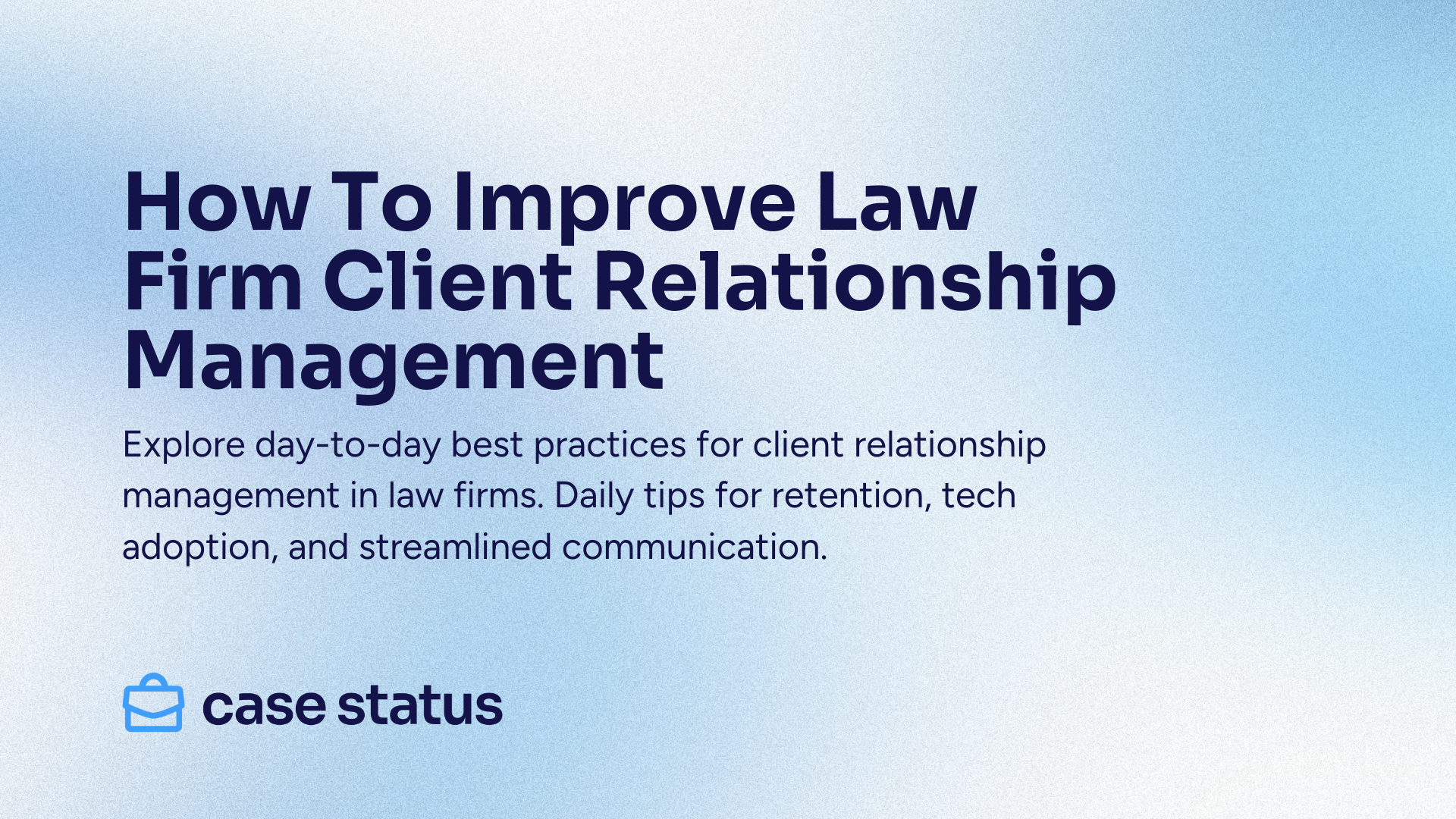.png)
Scattered emails, duplicate document versions, and “where is the latest file?” slow your firm's productivity and raise clients’ anxiety. A structured file-management process, driven by a clear checklist, keeps every matter organized from day one.
Checklists reduce human error, make ownership obvious, and ensure key files are captured the same way every time. This discipline also supports faster, clearer updates.
In our 2025 Legal Client Experience Report, one in four clients reported feeling anxiety from not knowing what was happening with their case, yet only 35% of firms measure response time.
You can use this checklist as your team’s shared playbook: consistent naming, predictable folder structure, a single secure channel for client-shared documents, and scheduled maintenance to keep files up to date.
How to Organize Legal Case Files Systematically
If your firm already has a system but people still ask, “Where’s the latest version?”, the problem isn’t effort — it’s structure.
Fixing a wobbly file operation means standardizing where things live, what they’re called, and who owns each step. Do that, and retrieval gets faster, collaboration is cleaner, and deadlines stop slipping.
- Pick a single source of truth. Decide where the live matter file resides, outside of email inboxes and personal drives. Move all client-shared documents and attorney outputs into the matter record, then enforce that policy.
- Lock in a universal folder map. Adopt one hierarchy for every matter, regardless of practice area. Numbered folders sort predictably and make it obvious where new items belong.
- Use names that sort themselves. Standardize a filename pattern, so people can find the proper document without opening it. Ban the use of too many spaces and “final_final.” If it’s truly final, lock it or export a signed PDF with the date.
- Put chronology inside each folder. Within each subfolder, rely on dates at the start of filenames, so items naturally appear in time order. Add filing receipts or e-file confirmations right after the filed document, so proof is always attached to the record.
- Assign ownership and make it visible. For each matter, name a “file captain” who polices the structure, closes loops on missing items, and runs periodic cleanups. Document this in a one-page standard operating procedure (SOP), and train on it. For broader operational guidance, see how to manage a law firm.
- Control access and keep an audit trail. Grant least-privilege permissions by role. Avoid sharing via ad-hoc email; route external sharing through your client portal, so messages and attachments land in the matter history with read receipts.
- Tie files to calendars and tasks. Every deadline-driven document should have a corresponding task with an owner and a due date. Store the filed version next to the tickler, plus proof of service or receipt.
- Schedule maintenance. Create a recurring “file hygiene” checklist (weekly for actives, monthly for pending, quarterly for archived) to remove duplicates, update statuses, and ensure billing support docs are present.
- Use client feedback to improve the system. If clients still call for documents you believe are “right there,” that’s a signal, not user error. Track those moments, and adjust folder maps or naming rules accordingly. You can automatically track client satisfaction to improve operational efficiency and spot patterns that point to fixable file issues.
3 Best Practices for Legal File Setup and Maintenance
When building a new file management system, aim for habits your team can repeat on every matter. These can be simple rules, visible ownership, and safeguards that catch mistakes early.
Done right, file maintenance doesn’t just benefit your attorneys and paralegals; it enhances the client experience and, over time, your firm's public reputation.
1. Establish Files Immediately with Standardized Intake Procedures
Create the matter file within 24-48 hours of engagement and follow the same intake sequence every time. Your checklist should capture client details, matter type, key dates, and conflicts-check results before any work starts.
Open the file in your case management system, apply the standard folder map, and record the first deadlines.
From day one, give clients a single place to share documents and see confirmations; modern portals make this easy and cut down on email chaos. The goal is a clean foundation: critical facts captured once, stored in the right place, and visible to everyone who needs them.
2. Implement Comprehensive Staff Training on File Protocols
Great systems fail without trained people. Build a short, mandatory curriculum for all roles that covers confidentiality, naming conventions, where files live, and how your client management system (CMS) and billing and calendaring tools connect.
You can use real scenarios, such as opening a personal injury case or closing an immigration matter, to rehearse the exact clicks, uploads, and audit notes you expect. Make the standards easy to find (one-page SOPs), and assign a file owner per matter so accountability is clear.
This approach reduces rework, prevents avoidable ethics issues, and gives clients faster, more confident answers when they ask for documents or status.
3. Conduct Regular File Audits and Maintenance Reviews
Schedule routine audits — for example, monthly for active matters and quarterly for pending and aging files.
Each pass should verify that key documents are present and dated, the latest orders or filings are in the record with proof of service, stale drafts are archived, billing support is complete, and the following milestones are on the calendar.
Use your CMS reports to surface files that are missing required artifacts or approaching deadlines. These short, consistent reviews keep matters tidy, protect compliance, and prevent last-minute scrambles that erode trust — inside the firm and with clients.
Physical vs. Digital Legal File Management Strategies
Most firms inherit a mix of banker boxes, network drives, and ad-hoc portals. Choosing a primary approach and writing simple rules for it can reduce cost, speed retrieval, and lower risk.
The core trade-offs can mostly be the same everywhere: speed and access versus originals and habit, plus how well your team can follow retention and security procedures.
Let's understand these types of files first:
- Physical files shine when originals must be preserved or a court requires wet signatures. They’re familiar and need little tech. But they’re slow to retrieve, hard to share, and vulnerable to loss, fire, or misfiling. Audits are manual, and only one person can use a folder at a time.
- Digital files are faster to find and easier to protect. Search, version history, role-based permissions, and audit trails improve accuracy and accountability. The risks shift to process (scanning quality, naming discipline) and security (you must enforce encryption, multifactor authentication, and vendor due diligence). Change management and training matter as much as the software you pick.
- Hybrid is practical during transition. Keep originals where required, but declare the digital matter file as the system of record. The hazard is duplication. Avoid it by setting clear rules: what gets scanned, where it goes, how it’s named, who verifies quality, and when paper is archived.
Moving to Digital Without Chaos
Most firms choose a digital matter file as the record of truth and keep paper only when originals are required. Use this quick side-by-side to decide what fits your risks, budget, and team habits — and where a hybrid makes sense during transition.
Improve Client Communication & Management With Case Status
Well-organized files don’t just make your back office tidier; they make client communication faster, more precise, and more consistent.
When your team can pull the proper document or status note in seconds, you answer questions on the spot, reduce follow-ups, and protect deadlines.
Firms using a client app as part of their communication stack see 80% client adoption and save 1,329 hours per year because updates, documents, and messages live in one place instead of scattered across email and voicemail.
Case Status ties file organization directly to the client experience:
- Single source of truth. Messages, documents, checklists, and case milestones live alongside each matter, so any staff member can provide a precise update without digging through threads.
- AI summaries for quicker responses. Case Status AI compiles messages, checklist items, and feedback into a concise case brief — useful when a client calls and you need the latest in seconds.
- Feedback at every stage. The built-in Client Feedback Tracker collects ratings and comments during the case, so you can address concerns early and spot patterns that point to filing or communication gaps.
Looking to modernize document work, too? See our practical guide on how to use AI for legal document management for drafting, summarizing, and organizing matter files more efficiently.

.png)

